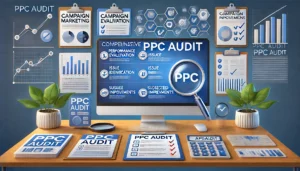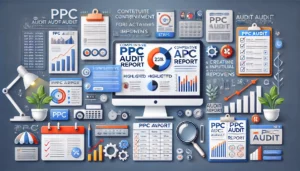What to Look for in a Comprehensive PPC Audit: A Complete Guide

What should I look for in a PPC audit?
In this guide, we’ll walk you through the step-by-step process of conducting a comprehensive PPC audit and what to look out for.
We’ll also help you create a comprehensive report to communicate your findings.
A PPC audit evaluates PPC campaign performance, identifies issues, and suggests improvements to enhance a campaign’s effectiveness.
Key Takeaways when considering: What should I look for in a PPC audit?
- A comprehensive PPC audit assesses campaign structure, ad performance, and budget allocation.
- Keyword effectiveness is crucial; focus on relevance, quality score, negative keywords, and search term reports.
- Analysing ad copy and creative elements, including A/B testing and ad extensions, can significantly improve campaign results.
- Effective bid strategies and budget management involve choosing between manual and automated bidding, and making bid adjustments for devices and locations.
- Tracking and measuring conversions accurately is essential for understanding the true performance of your PPC campaigns.
Understanding the Core Components of a PPC Audit
A comprehensive PPC audit is essential for uncovering potential issues and optimising your campaigns. By scrutinising these elements, a PPC audit uncovers any potential issues; some of which can be fixed in an instant, and others that require a much more thorough intervention. The goal is to uncover potential issues and improve the overall PPC performance of your ads. Let’s delve into the core components that make up a thorough PPC audit.
Evaluating Campaign Structure
The foundation of any successful PPC campaign lies in its structure. A well-organised campaign structure ensures that your ads are targeted effectively and your budget is utilised efficiently. Evaluate the hierarchy of your campaigns, ad groups, and keywords. Ensure that each ad group is tightly themed and relevant to the keywords it contains. This not only improves your Quality Score but also enhances the overall performance of your campaigns.
Analysing Ad Performance
Ad performance analysis is crucial for understanding which ads resonate with your audience and which do not. Look at key metrics such as click-through rate (CTR), conversion rate, and cost per conversion. Identify top-performing ads and analyse what makes them successful. Conversely, pinpoint underperforming ads and determine the reasons behind their lacklustre performance. This analysis will help you make data-driven decisions to optimise your ad copy and creative elements.
Reviewing Budget Allocation
Effective budget allocation is vital for maximising the return on investment (ROI) of your PPC campaigns. Review how your budget is distributed across different campaigns and ad groups. Ensure that high-performing campaigns receive adequate funding while underperforming ones are re-evaluated. Consider implementing a flexible budget strategy that allows for adjustments based on performance data. This approach ensures that your budget is always aligned with your campaign goals and market conditions.
What should I look for in a PPC audit? Assessing Keyword Effectiveness
Keyword Relevance and Quality Score
When evaluating your PPC campaign, it’s essential to assess the relevance of your keywords and their Quality Scores. High-quality scores indicate that your keywords, ads, and landing pages are highly relevant to what users are searching for. This relevance can lead to lower costs and better ad positions. Regularly review your keywords to ensure they align with your campaign goals and target audience.
Negative Keywords Analysis
Negative keywords are crucial for filtering out irrelevant traffic and ensuring your ads are shown to the right audience. Conduct a thorough analysis to identify terms that are not converting or are attracting the wrong audience. By refining your negative keyword list, you can improve your campaign’s efficiency and ROI.
Search Term Reports
Search term reports provide insights into the actual queries that trigger your ads. Use these reports to identify new keyword opportunities and to refine your existing keyword list. Look for patterns and trends to understand which search terms are driving the most valuable traffic. This analysis can help you optimise your keyword strategy and improve overall campaign performance.
A comprehensive keyword analysis is not just about immediate improvements but also about ensuring the long-term success of your PPC campaigns. Regularly updating and refining your keyword list is key to staying competitive and achieving your marketing goals.
Analysing Ad Copy and Creative Elements
Ad Copy Relevance and Quality
Assess your ad copy across key elements:
- Headlines – Do they grab attention? Establish relevance? Inspire click-throughs?
- Ad text – Is the copy compelling? Does it communicate key information?
- Landing page alignment – Does the ad align seamlessly with the landing page experience?
- Messaging – Does the copy feel fresh? Or is messaging getting stale and blending in?
A/B Testing Results
Analyse what your competitors are doing. What are their USPs? Calls to action? Promos and deals? Pay close attention to which keywords trigger which ad copy. To do this, click where it says “Keywords” under a specific ad. Use this information to gauge how your competitors are promoting solutions to users’ problems through their ad copy. Then, find ways to improve on what they’re doing.
Ad Extensions Utilisation
Ad extensions also greatly impact results by increasing visibility, engagement, and conversions. Review adoption of extensions like:
- Sitelink Extensions
- Callout Extensions
- Structured Snippets
- Call Extensions
Google ads agencies and Google advertising agencies should ensure that ad extensions are fully utilised to maximise the effectiveness of their campaigns.
Evaluating Bid Strategies and Budget Management
Manual vs. Automated Bidding
When it comes to bidding strategies, you have two primary options: manual and automated bidding. Manual bidding offers more control and flexibility, allowing you to adjust bids based on performance metrics and specific goals. On the other hand, automated bidding leverages machine learning to optimise bids in real-time, often leading to improved efficiency and performance. It’s advisable to test both approaches to determine which one aligns best with your campaign objectives.
Bid Adjustments for Devices and Locations
Bid adjustments are crucial for optimising your PPC campaigns. By adjusting bids for different devices and locations, you can ensure that your ads are shown to the most relevant audience. For instance, if you notice higher conversion rates on mobile devices, you might want to increase your bids for mobile traffic. Similarly, if certain locations yield better results, adjusting your bids accordingly can maximise your ROI.
Budget Pacing and Allocation (What should I look for in a PPC audit?)
Effective budget management is essential for the success of your PPC campaigns. Budget pacing involves distributing your budget evenly over a set period to avoid overspending early in the campaign. Additionally, allocating your budget based on performance data ensures that more funds are directed towards high-performing campaigns. This strategic approach helps in maintaining a balanced spend and achieving your campaign goals.
Properly evaluating your bid strategies and budget management can significantly impact your campaign’s performance and ROI. Regular audits and adjustments are key to staying competitive in the ever-evolving PPC landscape.
Tracking and Measuring Conversions
Conversion Tracking Setup
First and foremost, ensure that your account setup and tracking are correct. Cross-check your tracking URLs, conversions, goals, UTM parameters, and any other tracking elements. Also, verify that your site tracking is working and that all data is being correctly recorded. Without accurate tracking, you are hurting your PPC campaigns. Ask yourself:
- Are the conversion tags firing correctly?
- What data is not being captured?
- Is there any way we can better capture data that are not being recorded?
Analysing Conversion Paths
Understanding not just if conversions occurred, but how users interacted with your ads is crucial. Connect Google Ads to analytics platforms like Google Analytics to unlock deeper behavioural insights. Key areas Google Analytics reveals include:
- User journey from ad click to conversion
- Drop-off points in the conversion funnel
- Multi-channel attribution paths
Attribution Models are Key Aspects When Thinking “What should I look for in a PPC audit?”
Choosing the right attribution model is essential for understanding the true value of your PPC efforts. Different models can provide different insights, so it’s important to select one that aligns with your business goals. Consider models like:
In Google Ads, attribution models determine how credit for conversions is assigned to different ad interactions along a customer’s journey. Here’s a breakdown of the various models available:
Common Attribution Models:
-
Last Click Attribution (Default for most conversions): This model assigns 100% of the conversion credit to the last ad clicked before the conversion. It’s simple but may undervalue earlier touchpoints that influenced the user’s decision.
-
First Click Attribution: Grants all credit to the first ad a user clicks on their conversion path. Useful for understanding initial brand awareness efforts, but might overlook later interactions that secured the conversion.
-
Linear Attribution: Distributes conversion credit equally among all ad interactions leading to the conversion. Provides a balanced view but doesn’t account for the varying influence of each touchpoint.
-
Time Decay Attribution: Assigns more weight to ad interactions closer in time to the conversion, with earlier clicks receiving less credit. Reflects the diminishing influence of ads over time.
-
Position-Based Attribution: Splits credit between the first and last interactions, typically giving 40% each, with the remaining 20% distributed evenly among all clicks in between. Offers a middle ground between first and last click models.
Advanced Model:
Data-Driven Attribution (DDA) is Google Ads’ most powerful attribution model, but it requires a deeper dive to understand its nuances. Here’s a breakdown of its inner workings and considerations for use:
How DDA Works:
- Machine Learning: DDA leverages machine learning algorithms to analyse vast amounts of historical conversion data from your Google Ads account. This data includes clicks, impressions, website visits, app interactions, and ultimately, conversions.
- Identifying Patterns: The algorithm analyses user behaviour patterns across different touchpoints. It pinpoints which interactions (ad clicks, website visits, etc.) consistently precede conversions and assigns credit accordingly.
- Dynamic Credit Allocation: Unlike static models that assign a fixed percentage (e.g., 100% to last click), DDA dynamically distributes credit based on the data-driven insights. Interactions that have a statistically significant impact on conversions receive a higher proportion of the credit.
Benefits of DDA:
- More Accurate Attribution: By considering the entire user journey, DDA provides a more accurate picture of how each touchpoint contributes to conversions. This helps you understand which ad interactions are truly driving results.
- Data-Driven Optimisation: DDA insights can guide your campaign optimisation efforts. You can prioritise keywords, ad copy variations, and landing pages that have a higher impact based on the data.
- Holistic View: DDA goes beyond simple clicks and considers the entire customer journey, offering a more comprehensive understanding of your marketing funnel.
Things to Consider with DDA:
- Data Dependency: DDA requires a significant amount of historical conversion data to function effectively. If your account is new or has low conversion volume, DDA might not be as reliable.
- Black Box Nature: The exact algorithm behind DDA is not publicly available. While Google provides some insights, you cannot see the precise weight assigned to each touchpoint.
- Conversion Goal Specificity: DDA works best for specific conversion goals (e.g., purchases, sign-ups). It might not be as effective for broader goals like brand awareness.
Making the Most of DDA:
- Monitor Performance: Regularly review DDA’s attribution data to see how credit is being distributed across different touchpoints.
- Compare Models: Use the “Model Comparison” tool in Google Ads to compare DDA with other attribution models and see how it impacts your understanding of campaign performance.
- Focus on Trends: While the specific weightings might be opaque, focus on identifying trends in the data. For example, see if certain ad groups or keywords consistently receive higher credit, indicating their effectiveness.
By understanding the strengths and limitations of Data-Driven Attribution, you can leverage it effectively to gain deeper insights into your Google Ads campaigns and optimise your strategies for maximum return on ad spend (ROAS).
Choosing the Right Model:
- Consider your marketing goals.
- First or last click might be suitable for top-of-funnel or bottom-of-funnel conversions, respectively.
- Linear or time decay can be helpful for more complex customer journeys.
- Data-driven attribution is often the best choice for a comprehensive understanding, but requires sufficient data.
Additional Tips:
- Utilise the “Model Comparison” tool in Google Ads to see how conversions would be attributed under different models.
- You can set different attribution models for various conversion actions based on your specific goals.
- Regularly review and adjust your attribution model as your campaigns evolve and your understanding of user behaviour improves.
By effectively using attribution models in Google Ads, you can gain valuable insights into your ad campaign performance and optimise your strategies for better results.
Investing time in implementing durable tracking solutions like enhanced conversions and offline conversion imports can significantly improve the accuracy of your measurement.
Utilising PPC Audit Tools for Better Insights (What should I look for in a PPC audit?)
Comprehensive Feature Coverage
When selecting a PPC audit tool, it’s crucial to ensure it offers comprehensive feature coverage. A successful PPC campaign audit ensures you allocate your resources to the most profitable areas. Look for tools that can analyse various aspects of your campaigns, such as keyword performance, ad copy effectiveness, and budget allocation. This will help you get a holistic view of your Google ads PPC efforts.
Integration Capabilities
Integration capabilities are essential for a seamless auditing process. The best PPC audit tools should easily integrate with platforms like Google Adwords PPC, Bing Ads, and social media advertising channels. This ensures that you can gather all necessary data in one place, making your PPC management more efficient and less time-consuming.
User-Friendliness and Support
User-friendliness and support are often overlooked but are critical factors. A tool that is easy to navigate will save you time and reduce the learning curve. Additionally, having access to reliable customer support can be a lifesaver when you encounter issues. Whether you are a PPC ad agency or an eCommerce PPC specialist, these features can significantly impact your workflow.
Using a PPC audit dashboard makes detecting any changes made and their impact on campaign performance fast. Monitoring key performance indicators (KPIs) in real-time will provide insights into PPC channels which yield the best results.
Building a Comprehensive PPC Audit Report
Organising Your Findings
When building a comprehensive PPC audit report, the first step is to organise your findings systematically. Start by categorising the data into sections such as campaign structure, keyword effectiveness, ad performance, and budget allocation. This will make it easier for stakeholders to digest the information. A well-organised report is crucial for effective communication.
Visualising Data with Charts and Graphs
Visual aids like charts and graphs can significantly enhance the readability of your PPC audit report. Use bar charts to compare keyword performance, pie charts for budget allocation, and line graphs to show trends over time. These visual elements help in quickly conveying complex data insights.
Actionable Recommendations
The final section of your PPC audit report should focus on actionable recommendations. Based on your findings, suggest specific actions to improve campaign performance. For instance, if certain keywords are underperforming, recommend pausing them or adjusting bids. If ad copy is not resonating, suggest A/B testing new variations. Actionable insights are what turn a good audit into a great one.
A comprehensive PPC audit report not only highlights issues but also provides a roadmap for future improvements. This is where the expertise of a PPC agency or a specialised London PPC agency can be invaluable.
By following these steps, you can create a PPC audit report that is both informative and actionable, setting the stage for continuous improvement in your campaigns.
What should I look for in a PPC audit: Conclusion
Conducting a comprehensive PPC audit is an essential practice for ensuring the success and efficiency of your PPC campaigns. By following the step-by-step process outlined in this guide, you can identify areas of improvement, optimise your ad performance, and ultimately achieve better ROI. Remember, a thorough audit not only evaluates your current campaign metrics but also provides actionable insights for future strategies. Utilise the best PPC audit tools, integrate your findings into a cohesive report, and continuously monitor your campaigns to stay ahead of the competition. With the right approach, your PPC efforts can drive significant growth and success for your business.
Frequently Asked Questions For What You should look for in a PPC audit.
What should I look for in a PPC audit?
In a PPC audit, you should evaluate campaign structure, analyse ad performance, review budget allocation, assess keyword effectiveness, analyse ad copy and creative elements, evaluate bid strategies and budget management, track and measure conversions, and utilise PPC audit tools for better insights.
Why should I conduct a PPC audit?
Conducting a PPC audit helps you identify issues in your campaigns, optimise performance, allocate your budget more effectively, and ultimately improve your return on investment (ROI).
What is a PPC audit?
A PPC audit evaluates the performance of your PPC campaigns, identifies issues, and suggests improvements to enhance the effectiveness of your campaigns.
How often should I perform a PPC audit?
It’s recommended to perform a PPC audit at least once every quarter. However, the frequency can vary depending on your campaign’s size, complexity, and performance goals.
What tools can I use for a PPC audit?
There are various tools available for PPC audits, such as Google Ads Editor, SEMrush, Ahrefs, and others. Look for tools that offer comprehensive feature coverage, integration capabilities, and user-friendliness.
How do I communicate my PPC audit findings?
Organise your findings in a comprehensive PPC audit report, visualise data with charts and graphs, and provide actionable recommendations to improve campaign performance.
The Art of Communicating PPC Audit Findings: A Storyteller’s Approach
Imagine you’re a seasoned adventurer, embarking on a journey to uncover the secrets hidden within a client’s Pay-Per-Click (PPC) campaigns. Your mission? To unravel the tangled web of data, identify areas for improvement, and chart a course towards optimised performance.
As you set out on this expedition, your first task is to craft a compelling PPC audit report – a roadmap that will guide your client through the maze of findings and recommendations. But this is no ordinary report; it’s a tale of discovery and opportunity, where every detail holds the key to unlocking the full potential of their online advertising efforts.
Crafting the Narrative: The PPC Audit Report
Like any great storyteller, you need to capture your audience’s attention from the very beginning. The executive summary serves as your prologue, providing a tantalising glimpse into the journey ahead, highlighting the key findings and recommendations that will shape the narrative.
With the stage set, you delve deeper into the heart of the tale, dedicating sections to specific areas of exploration – keyword relevance, ad copy effectiveness, landing page optimisation, and budget allocation. Each chapter unveils new insights, painting a vivid picture of the campaign’s current state and the untapped opportunities that lie within.
But a great story is not complete without visuals that bring the words to life. That’s where data visualisation comes into play, allowing you to weave charts, graphs, and screenshots into the narrative, transforming cold numbers into compelling visuals that resonate with your audience.
As the plot thickens, you present your actionable recommendations – the turning points in the story, where you propose specific steps to improve campaign performance. Like a master strategist, you prioritise these recommendations based on their potential impact, guiding your client towards the most rewarding paths.
Finally, the conclusion serves as the denouement, tying together the various threads of the narrative and reinforcing the potential benefits of implementing your recommendations. It’s a moment of reflection, where you remind your client of the journey they’ve embarked upon and the rewards that await at the end of the trail.
Tailoring the Tale for Your Audience
But a great story is not just about the narrative itself; it’s also about understanding your audience and tailoring the tale to their unique perspectives and needs. That’s why it’s crucial to consider your audience and adapt your report’s language and technical depth accordingly.
For non-technical stakeholders, clarity and concision reign supreme. Use straightforward explanations and focus on the broader business impacts, quantifying the potential improvements in metrics like conversions, return on ad spend (ROAS), and cost-per-acquisition (CPA). This approach demonstrates the true value of your recommendations and resonates with those who prioritise the bottom line.
On the other hand, for PPC specialists, you can delve into the finer details, providing a granular analysis that speaks directly to their expertise. Engage them with the intricacies of your findings and the nuances of your recommendations, fostering a collaborative dialogue that empowers them to take ownership of the optimisation process.
Bringing the Story to Life
With the narrative crafted and the audience in mind, it’s time to bring your story to life. Choose a presentation format that aligns with your audience’s preferences – whether it’s a captivating slide deck, an interactive dashboard, or a meticulously formatted PDF report.
But don’t just present data; tell a story. Use visuals and clear explanations to connect the dots between your findings and the recommended actions, highlighting areas for improvement and the potential benefits of optimisation. This approach transforms your audit report from a mere collection of numbers into a compelling narrative that resonates with your audience on a deeper level.
The Final Chapter: Ongoing Support and Follow-Up (What should I look for in a PPC audit?)
Your role as a storyteller doesn’t end with the presentation of your findings. Offer ongoing support to your client as they implement your recommendations, fostering a collaborative relationship built on trust and understanding. This not only demonstrates your commitment to their success but also opens the door for additional opportunities to refine and optimise their campaigns.
Furthermore, schedule a follow-up meeting to discuss the audit report in detail. This interactive discussion allows you to address any questions, clarify your recommendations, and ensure that everyone is on the same page. It’s a chance to reinforce the narrative and keep the momentum of your story alive.
By embracing the art of storytelling and following these principles, you can effectively communicate your PPC audit findings, captivate your audience, and ultimately empower your clients to optimise their campaigns and drive significant improvements in their online advertising performance.
Author
Search Blog
Free PPC Audit
Subscribe to our Newsletter
The Voices of Our Success: Your Words, Our Pride
Don't just take our word for it. With over 100+ five-star reviews, we let our work-and our satisfied clients-speak for us.
"We have been working with PPC Geeks for around 6 months and have found Mark and the team to be very impressive. Having worked with a few companies in this and similar sectors, I rate PPC Geeks as the strongest I have come across. They have taken time to understand our business, our market and competitors and supported us to devise a strategy to generate business. I value the expertise Mark and his team provide and trust them to make the best recommendations for the long-term."
~ Just Go, Alasdair Anderson







